Hyundai Tucson: Camshaft Position Sensor (CMPS)
Description
Camshaft Position Sensor (CMPS) is a hall sensor and detects the camshaft position by using a hall element.
It is related with Crankshaft Position Sensor (CKPS) and detects the piston position of each cylinder which the CKPS can't detect.
The CMPS is installed on engine head cover and uses a target wheel installed on the camshaft. The Cam Position sensor is a hall-effect type sensor. As the target wheel passes the Hall sensor, the magnetic field changes in the sensor. The sensor then switches a signal which creates a square wave.
Bank 1 / Intake

Bank 1 / Exhaust
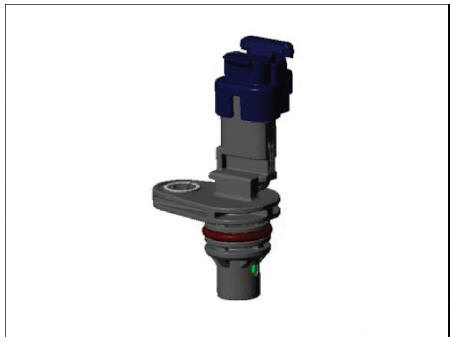
Circuit Diagram
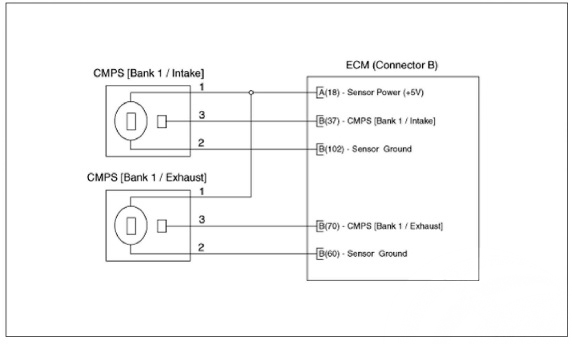
Harness Connector CMPS Bank 1 / Intake
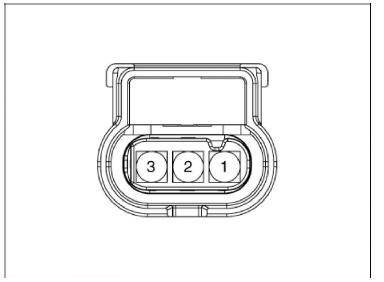
CMPS Bank 1 / Exhaust
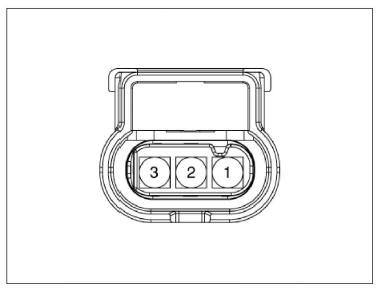
Inspection
- Check signal waveform of CKPS and CMPS using a diagnostic tool.
Specification : Refer to "DTC Diagnosis Guide"
Removal
WARNING
DON'T remove the camshaft position sensor during engine running or right after engine stops, or a scald by the flowed out engine oil may occur.
Bank 1 / Intake
- Turn ignition switch OFF and disconnect the battery negative (-) terminal.
- Disconnect the camshaft position sensor connector (A).
- Remove the installation bolt, and then remove the sensor (B).
Tightening Torque : 9.8 - 11.8 N.m (1.0 - 1.2 kgf.m, 7.2 - 8.7 lb-ft)
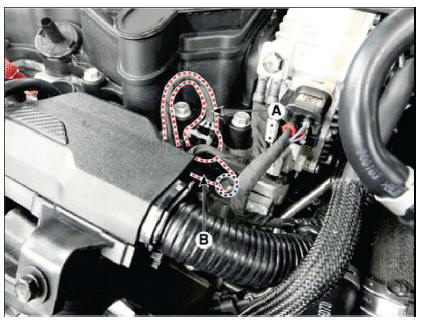
Bank 1 / Exhaust
- Turn ignition switch OFF and disconnect the battery negative (-) terminal.
- Disconnect the camshaft position sensor connector (A).
- Remove the installation bolt, and then remove the sensor (B).
Tightening Torque : 9.8 - 11.8 N.m (1.0 - 1.2 kgf.m, 7.2 - 8.7 lb-ft)
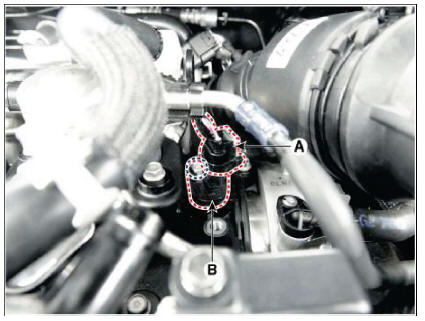
Installation
WARNING
- Install the component with the specified torques.
- Note that internal damage may occur when the component is dropped. If the component has been dropped, inspect before installing.
WARNING
Apply the engine coolant to the O-ring.
WARNING
Insert the sensor in the installation hole and be careful not to damage.
- Install in the reverse order of removal.
READ NEXT:
 Knock Sensor (KS)
Knock Sensor (KS)
Description
Knocking is a phenomenon characterized by undesirable vibration and noise and
can cause engine
damage.
Knock Sensor (KS) is installed on the cylinder block and senses engine knocking.
When knocking
occurs, the vibration from the
 Heated Oxygen Sensor (H02S)
Heated Oxygen Sensor (H02S)
Description
Heated Oxygen Sensor (HO2S) consists of the zirconium and the alumina and is
installed on upstream
and downstream of the Manifold Catalyst Converter (MCC).
In order that this sensor normally operates, the temperature of the sensor
 Exhaust Gas Temperature Sensor (EGTS)
Exhaust Gas Temperature Sensor (EGTS)
Description
Exhaust Gas Temperature Sensor (EGTS) is installed on Gasoline Particulate
Filter (GPF) senses the
temperature of exhaust gas flowing into. When pre-determined engine condition is
set, ECM burns
soot gathered in GPF with exhaust ga
SEE MORE:
 Condensor
Condensor
Components Location
Condensor
Inspection
Check the condenser fins for clogging and damage. If clogged, clean them
with water, and blow them with compressed air. If
bent, gently bend them using a screwdriver or pliers.
Check the co
 Idle Stop and Go (ISG)
Idle Stop and Go (ISG)
Idle Stop and Go helps reduce fuel
consumption by automatically shutting
down the engine, when the vehicle is
at a standstill (i.e. red stop light, stop
sign, and traffic jam) subject to certain
prerequisite conditions being satisfied as
listed
Information
- Home
- Hyundai Tucson - Fourth generation (NX4) - (2020-2023) - Owner's Manual
- Hyundai Tucson - Fourth generation (NX4) - (2020-2023) - Workshop Manual